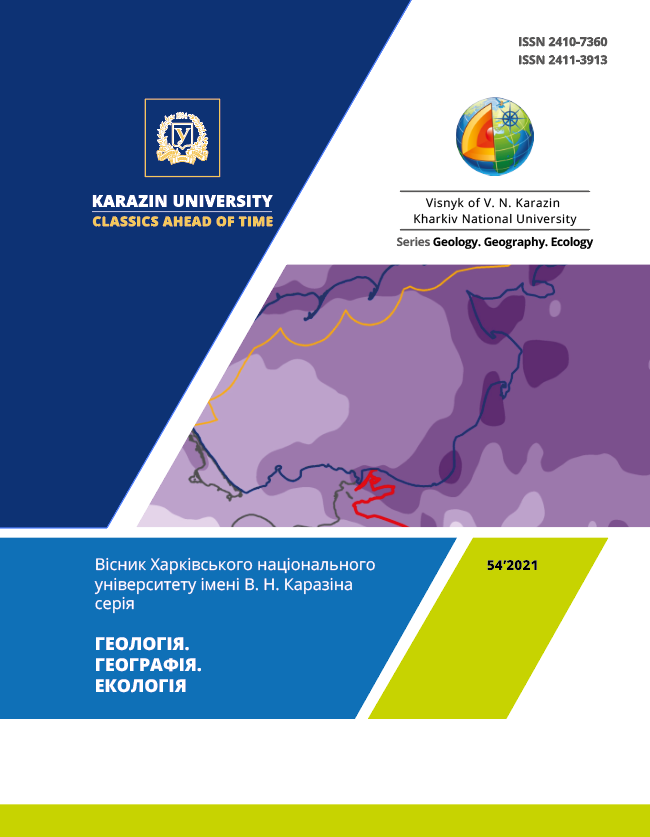Оцінка мікрокомпонентного забруднення снігового покриву гірських вершин Українських Карпат
Анотація
Сьогодні територію України можна розділити на урбанізовані райони та умовно чисті, віддалені від великих джерел промислових забруднень, такі, як Карпатський біосферний заповідник (КБЗ). Необхідно наголосити, що в такому випадку, аналіз ведеться лише на основі фонового підходу. Зважаючи на те, що постійних спостережень щодо мікрокомонентного складу забруднення снігового покриву не ведеться, метою роботи є оцінка і аналіз рівня забруднення снігу у 2019 році та виявлення можливих джерел забруднення. Об’єктами дослідження обрано сніговий покрив гірських вершин заповідних масивів КБЗ – гора Вежа (Угольсько-Широколужанський масив), гори Стіг, Драгобрат, Малий Менчул (Свидовецький масив), гори Петрос Чорногірський, Гропа, Говерла (Чорногірський масив), гори Менчул Рахівський, Темпа (Рахів-Кузійський масив), гора Петрос Мармароський (Мармароський масив). Для еколого-геохімічної оцінки снігового покриву були застосовані коефіцієнти концентрації (Кс) хімічних елементів (Be, V, Cr, Co, Ni, Cu, Zn, As, Rb, Sr, Cd, Cs, Ba, Tl, Pb, Bi) відносно фонового вмісту. Рівень забруднення снігового покриву класифікувався категоріями – розсіяні (Kc <1), близькі до середніх концентрацій (Kc 1–3,9), такі, що накопичуються (Kc> 4 – 10) і сильно накопичуються (Kc > 10). В результаті проведених досліджень отримано асоціацію елементів-забруднювачів снігового покриву (талих вод): Pb, V, Ni, Co (гора Вежа); Ni, Ba, Co (гора Стіг); V, Со, Ni, Ba, Cu (гора Драгобрат); Zn, Cr (гора Малий Менчул); Sr (гора Гропа). У сніговому покриві гірських вершин Темпа, Менчул, Петрос Чорногірський, Петрос Мармароський – забруднення не виявлено (відносно фонового вмісту). В результаті аналізу викидів (мікроелементний склад) стаціонарних джерел (промислових підприємств) обґрунтовано можливий їхній внесок у забруднення снігового покриву. Отримані результати є основою для розробок природоохоронних рекомендацій відносно заповідних територій регіону та зменшення викидів забруднюючих речовин від стаціонарних джерел.
Завантаження
Посилання
Sedunov Yu.S., Avdyushin S.I., Borisenkov E.P. (1991). Atmosphere. Directory. (reference data, models). Lenin-grad.: Gidrometeoizdat, 510.
Dmitriev M.T., Kaznina N.I., Pinigin I.O. (1989). Sanitary-chemical analysis of pollutants in the environment: ref-erence book. M., Chemistry, 368.
Law of Ukraine on the Basic Principles (Strategy) of the State Environmental Policy of Ukraine for the period up to 2030. Electronic resource. Available at: URL: https://zakon.rada.gov.ua/laws/show/2697-19
Li Y., Li Z., Cozzi G., Turetta C., Barbante C. (2018). Signals of pollution revealed by trace elements in recent snow from mountain glaciers at the Qinghai-Tibetan plateau. Сhemosphere, 523‒531. DOI: https://doi.org/10.1016/j.chemosphere.2018.01.039
Kholodov A., Golokhvast K. (2020). Air Pollution of Nature Reserves near Cities in Russia. Scientifica. DOI: https://doi.org/10.1155/2020/9148416
Casey K. A., Kaspari S.D., Skiles S.M., Kreutz K.,. Handley M. J.(2017). The spectral and chemical measurement of pollutants on snow near South Pole, ntarctica. JGR Atmospheres, 6592-6610. DOI: https://doi.org/10.1002/2016JD026418
Carpathian Biosphere Reserve. Electronic resource. Available at: http://cbr.nature.org.ua/ukrainian.htm
Zhovinsky E.Ya., Kryuchenko N.O., Paparyga P.S. (2012). Geochemistry of environmental objects of the Carpathi-an Biosphere Reserve. Kiev: TOV "NVP Interservice", 100.
Kryuchenko N.O., Zhovinsky E.Ya., Paparyga P.S. (2018). Ore and technogenic geochemical anomalies of protect-ed areas of the Ukrainian Carpathians (on the example of the Carpathian Biosphere Reserve). Kiev: TOV "NVP In-terservice", 148.
Kovkin V.V., Shuvaeva O. V., Morozov S.V., Ranuta V.F. (2012). Guidelines for methods of field and laboratory studies of snow cover for studying the patterns of long-term pollution of the area in the zone of anthropogenic sources: Methodological manual. Novosibirsk: Novosib. State Un-t, 85.
Saet Yu.I. (1990). Environmental Geochemistry. Moscow, Nauka, 335.
Sushchik Yu.Ya. (1978). Geochemistry of the hypergenesis zone of the Ukrainian Carpathians. Kiev, Naukova dumka, 210.
Pipash L.I., Paparyga P.S. Monitoring of hydrochemical composition of atmospheric precipitation in the Carpa-thian Biosphere Reserve (2016). Nature of the Carpathians, 1, 95–100.
Miklishansky A.Z., Yakovlev Yu.V, Vyropaev V. Ya. (1976). Neutron activation and X-ray radiometric determination of the content of trace elements in the snow cover of Antarctica. Moscow, Publishing Department of the Joint Insti-tute for Nuclear Research, 9.
Maximum permissible concentration of the content of basic inorganic substances in drinking water. Electronic resource. Available at: https://www.water.ru/bz/param/neorg.php
Catalog of industrial enterprises of Ukraine (Ukrprom). 2018. Available at: URL: http://www.ukr-prom.com.
Kryuchenko N.O., Zhovinsky E.Ya., Paparyga P.S. (2019). Technogenic pollution (microelement composition) of snow cover of mountain peaks of the Carpathian Biosphere Reserve. Geochemistry and ore formation, 40, 6‒14. DOI: https://doi.org/10.15407/gof.2019.40.006.
Periodic table of elements. Available at: URL: http://www.himsnab-spb.ru/article/ps/
Vasilenko V.N., Nazarov I.M., Fridman Sh.D. (1985). Monitoring of snow cover pollution. Leningrad, Gidromete-oizdat, 180.
Alemasova A.S. (2010). Environmental analytical chemistry. Donetsk, DonNU, 271.





